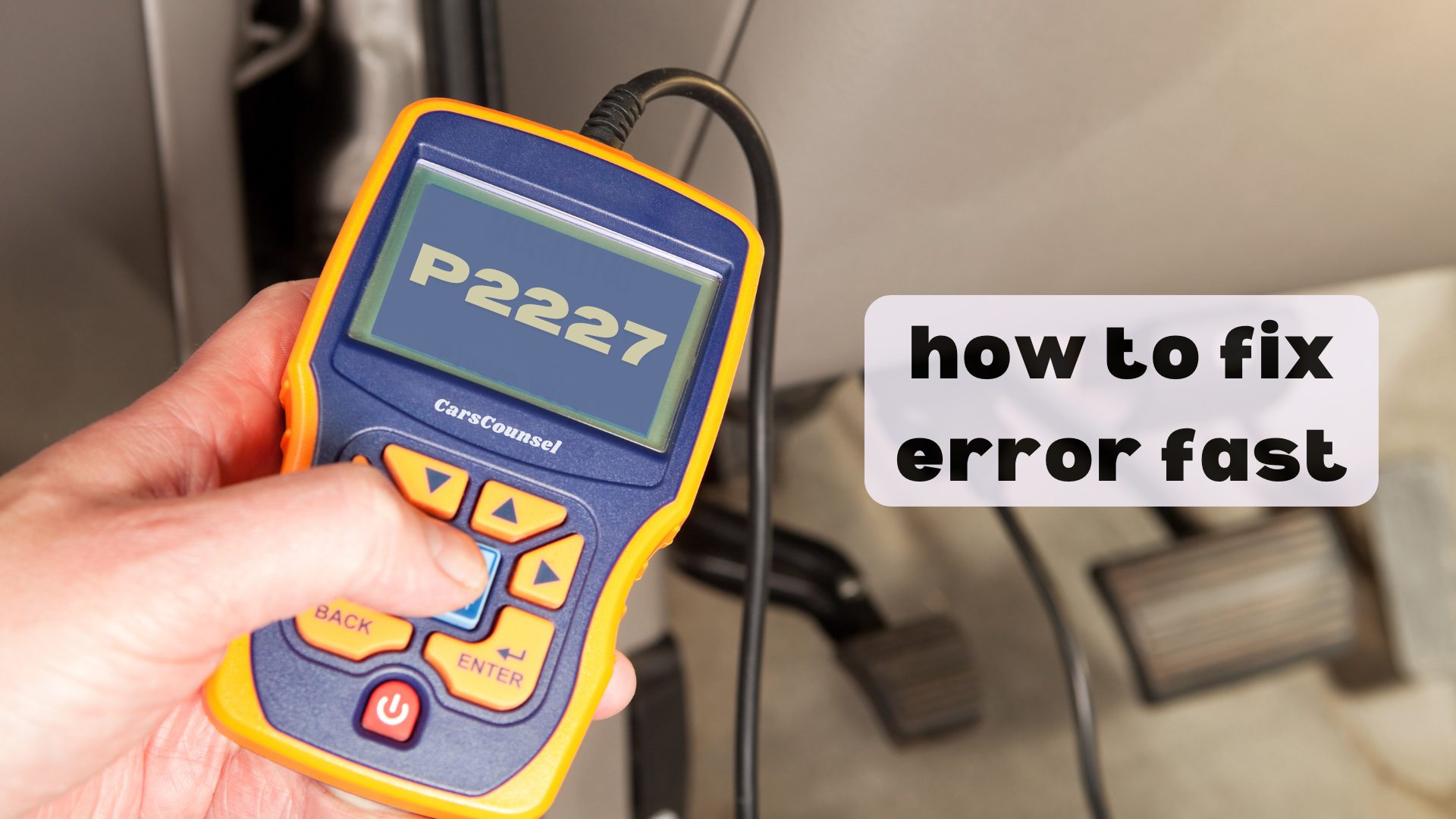The P2227 code means there’s a problem with your vehicle’s barometric pressure sensor, which is crucial for optimal engine performance.
Fixing this OBD2 Codes error isn’t just about resetting the code. You’ll need to check the sensor and its wiring, replace any damaged parts, and test everything to make sure it works right.
This might seem overwhelming, but knowing each step can save you time and money.
So, how do you handle these repairs quickly and efficiently?

Quick Navigation
Key Takeaways
- Swap out the broken barometric pressure sensor with a good quality one.
- Check and fix any damaged wires or rusty connectors.
- Use an OBD2 scanner to find and erase the error code.
- Do regular maintenance to avoid future problems.
Understanding the P2227 Code
The P2227 code means that your car’s barometric pressure sensor is sending signals to the Engine Control Module (ECM) that are outside the normal range. This sensor measures the atmospheric pressure and sends this information to the ECM.
If the sensor is faulty, it sends incorrect data, causing the ECM to misinterpret it. Sometimes, even a good sensor can send accurate signals that a faulty ECM misreads, making it harder to diagnose the problem.
These issues can be due to sensor wear and tear, exposure to harsh conditions, or manufacturing defects. A bad barometric sensor can affect your car’s performance and fuel efficiency, so it’s important to fix it as soon as possible.
Regular maintenance and quick attention to sensor problems can prevent ECM issues and keep your car running smoothly. Understanding this code is the first step to fixing the problem.
Implications of P2227 Code
If you see a P2227 code, it’s a sign that your car’s engine mightn’t be running well, and you could be using more fuel than usual.
This code means there’s a problem with the barometric pressure sensor, which helps the engine control module (ECM) measure air pressure correctly. When this sensor isn’t working right, your car might’ve poor acceleration, a rough idle, and increased fuel consumption.
Ignoring this issue can lead to more damage and higher repair costs. It’s important to keep up with regular maintenance and fix sensor problems quickly to keep your car running efficiently and avoid harming the environment.
Common Causes of P2227
Several things can cause a P2227 code, mainly problems with the barometric pressure sensor and related parts. These sensors can go bad due to wear and tear, extreme temperatures, or humidity, so keeping them in good shape is important.
Damaged wires or connections, often from corrosion or physical damage, can mess up the signal and cause this error code. Fixing wiring issues quickly is crucial for proper sensor function.
Sometimes, a faulty ECM might misread sensor signals and show incorrect errors. Environmental factors, especially in off-road conditions, can also damage sensors.
Manufacturing defects in OEM sensors can be a problem too, so regular checks and maintenance are necessary.
Effects on Engine Performance
When your car’s barometric pressure sensor isn’t working right, you’ll likely notice a big drop in how well your engine runs. This problem messes with engine efficiency and leads to worse performance.
You’ll see things like:
- Less Power: The engine can’t keep up its usual power.
- Sluggish Acceleration: Your car struggles to speed up, especially when carrying extra weight.
- Rough Idling: The engine runs unevenly and vibrates when it’s idling.
- Worse Fuel Efficiency: Your car uses more gas because the engine is trying to adjust to bad sensor data.
A faulty barometric pressure sensor throws off the air-fuel mix, making it hard for the engine control module (ECM) to keep up with changing conditions.
This imbalance makes the engine run less efficiently and can lead to more damage if you don’t fix it soon.
Identifying Symptoms
Identifying Symptoms
To spot issues with a faulty barometric pressure sensor, watch out for signs like lower engine performance, poor acceleration, and a rough idle. Managing these symptoms effectively is crucial for keeping your engine in good shape and preventing further damage. Ignoring the P2227 code can also lead to lower fuel efficiency and safety concerns. By catching these symptoms early, you can avoid bigger problems later on.
| Symptom | Possible Effect |
|---|---|
| Lower Engine Performance | Puts strain on engine parts |
| Poor Acceleration | Creates safety risks |
| Rough Idle | Leads to unstable engine running |
| Lower Fuel Efficiency | Results in higher fuel costs |
Regular checks help ensure your vehicle runs smoothly and safely.
Using an OBD2 Scanner
Using an OBD2 scanner can help you read and understand trouble codes like P2227, which is crucial for diagnosing and fixing issues with your car. These scanners give you clear insights into your vehicle’s condition.
Here are some tips for using the scanner efficiently:
- Connect Properly: Make sure the scanner is securely connected to the diagnostic port to avoid errors.
- Follow Instructions: Different scanners might have unique steps for reading codes, so always follow the manufacturer’s guidelines.
- Understand the Codes: Look up what each trouble code means to identify the problem accurately.
- Clear Codes After Fixing: Once you’ve made the repairs, clear the codes to check if the problem is resolved.
Using an OBD2 scanner correctly can save you time and stop more damage from happening.
Conducting Visual Inspections
Start your visual check by looking at the barometric pressure sensor and the wires around it for any signs of damage or wear.
Look for corrosion, frayed wires, or loose connections. Use a flashlight and magnifying glass to see small details more clearly.
Pay extra attention to connectors, as they often get corroded. Make sure all wires are securely attached and clean.
If you find any damaged parts, replace them right away to prevent more problems.
Carefully inspecting these areas can help you spot and fix issues quickly, reducing the chances of recurring P2227 codes and improving overall engine performance.
Testing Circuits and Components
When you’re trying to figure out what’s causing the P2227 code, you need to check the circuits and parts to make sure they’re working right and sending accurate signals.
Start by looking at the circuits to ensure there are no breaks in the signal paths. Use a multimeter to check the components and confirm voltage and resistance levels.
Here’s how to do it step-by-step:
- Check Voltage: Measure the voltage at the sensor to make sure it’s within the correct range.
- Inspect Resistance: Test the wiring for any breaks or shorts by checking the resistance.
- Signal Continuity: Make sure the signals from the sensor to the ECM are continuous and not blocked.
- Component Functionality: Check that the barometric pressure sensor and ECM are working properly.
Accurate testing is essential to find the problem.
Effective Repair Solutions
Once you’ve made sure the circuit and parts are working correctly, it’s time to fix the P2227 code and get your vehicle running smoothly again.
Start by swapping out the faulty barometric sensor with a good-quality one to ensure accurate pressure readings.
Look for and repair any damaged wires or rusty connectors that might mess with the sensor’s signal.
Also, clean or replace the air filter to help the engine run better and keep the sensor from getting dirty.
Regular maintenance, like checking the barometric sensor and related systems, will help you catch problems early and keep your vehicle in top shape.
Preventing Future Issues
To avoid problems with the P2227 code in the future, make sure you regularly check and quickly fix any signs of wear or damage in the barometric pressure sensor and its related parts. Routine maintenance and using good quality sensors are essential.
Here are some key steps:
- Check Regularly: Schedule regular maintenance to inspect the sensor and its wiring.
- Use Good Quality Sensors: Always choose sensors with a reliable performance record.
- Keep an Eye on the ECM: Make sure the Engine Control Module (ECM) is reading the sensor data correctly.
- Protect from the Elements: Shield the sensors from harsh conditions and debris.
More OBD-II Codes
Frequently Asked Questions
Can a P2227 Code Affect My Vehicle’s Emissions Test Results?
Yes, a P2227 code can affect your vehicle’s emissions test results. It messes with how your car reads air pressure, which can cause the engine to burn fuel inefficiently and produce more emissions. This might make your car fail the emissions test.
How Long Can I Drive With a P2227 Code Before Serious Damage Occurs?
You might be asking, “How long can I drive with a P2227 code before serious damage happens?” The answer? Not long at all. The symptoms of a P2227 code get worse quickly. It’s really important to get it checked out right away to stop more engine problems from happening.
Are There Any Software Updates That Can Help Resolve a P2227 Code?
You can fix a P2227 code by checking for software updates from your car’s manufacturer. Use diagnostic tools to make sure the software works with your car’s ECM. These updates might recalibrate the sensors and solve the problem.
What Are the Costs Associated With Fixing a P2227 Code Issue?
Fixing a P2227 code issue usually costs between $100 and $400. You’ll also need to pay about $50 to $100 for the diagnostic check. The total cost can vary depending on your car’s make and model and if you need any extra repairs.
Can Aftermarket Modifications Cause a P2227 Code to Appear?
Think of your car’s sensors like its nerve endings; adding aftermarket sensors or making tuning changes can definitely cause a P2227 code to show up. Incorrect readings or improper calibrations from these modifications often confuse the car’s computer, leading to errors.
Conclusion
By fixing the P2227 code quickly, you’re making sure your engine runs well and lasts longer.
Did you know a bad barometric pressure sensor can cut your fuel efficiency by up to 20%? Regular maintenance and quick repairs can prevent expensive problems later on.
Don’t forget to do visual checks and test the circuits. Keeping your sensor and ECM in good condition is crucial.
Stay on top of things to keep your car running smoothly and efficiently.

